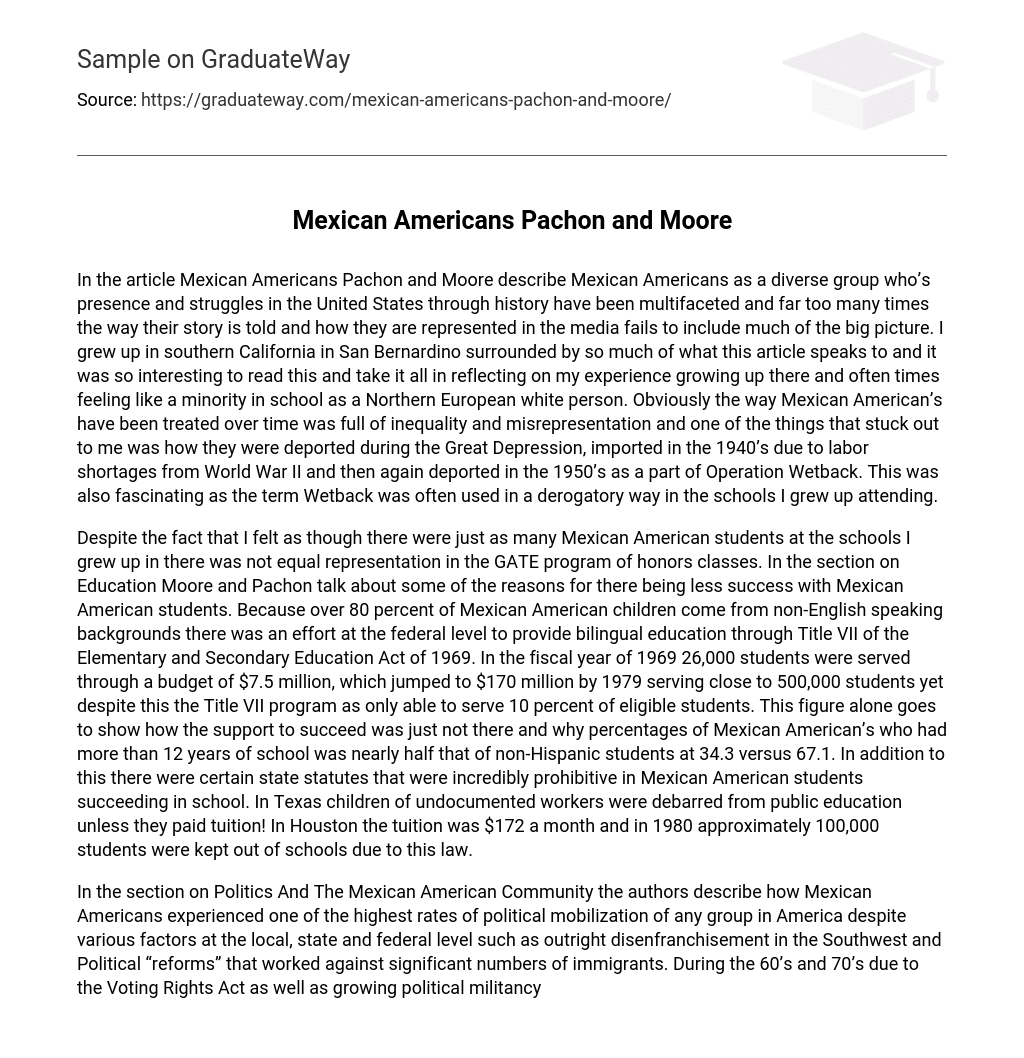In the article Mexican Americans Pachon and Moore describe Mexican Americans as a diverse group who’s presence and struggles in the United States through history have been multifaceted and far too many times the way their story is told and how they are represented in the media fails to include much of the big picture. I grew up in southern California in San Bernardino surrounded by so much of what this article speaks to and it was so interesting to read this and take it all in reflecting on my experience growing up there and often times feeling like a minority in school as a Northern European white person. Obviously the way Mexican American’s have been treated over time was full of inequality and misrepresentation and one of the things that stuck out to me was how they were deported during the Great Depression, imported in the 1940’s due to labor shortages from World War II and then again deported in the 1950’s as a part of Operation Wetback. This was also fascinating as the term Wetback was often used in a derogatory way in the schools I grew up attending.
Despite the fact that I felt as though there were just as many Mexican American students at the schools I grew up in there was not equal representation in the GATE program of honors classes. In the section on Education Moore and Pachon talk about some of the reasons for there being less success with Mexican American students. Because over 80 percent of Mexican American children come from non-English speaking backgrounds there was an effort at the federal level to provide bilingual education through Title VII of the Elementary and Secondary Education Act of 1969. In the fiscal year of 1969 26,000 students were served through a budget of $7.5 million, which jumped to $170 million by 1979 serving close to 500,000 students yet despite this the Title VII program as only able to serve 10 percent of eligible students. This figure alone goes to show how the support to succeed was just not there and why percentages of Mexican American’s who had more than 12 years of school was nearly half that of non-Hispanic students at 34.3 versus 67.1. In addition to this there were certain state statutes that were incredibly prohibitive in Mexican American students succeeding in school. In Texas children of undocumented workers were debarred from public education unless they paid tuition! In Houston the tuition was $172 a month and in 1980 approximately 100,000 students were kept out of schools due to this law.
In the section on Politics And The Mexican American Community the authors describe how Mexican Americans experienced one of the highest rates of political mobilization of any group in America despite various factors at the local, state and federal level such as outright disenfranchisement in the Southwest and Political “reforms” that worked against significant numbers of immigrants. During the 60’s and 70’s due to the Voting Rights Act as well as growing political militancy there was a substantial increase in the amount of Mexican American elected officials at the state level. In 1950 there were a total of 20 Mexican American state legislators in office and by 1979 that number totaled 82 between Arizona, California, Colorado, New Mexico and Texas. Although this increase was not reflected at the federal level at the time of this article but according to an article by the Congressional Research Service as of December 20th, 2018 there were 46 Hispanic or Latino members of Congress with 41 in the House and 5 in the Senate. In presidential politics there was a significant display of Mexican American’s political power when in 1960 “Viva Kennedy” was established bringing thousands of Mexican American voters to the polls and in 1969 the Mexican American vote was the swing vote in carrying Texas for the Democratic candidate.
When looking at Economic Opportunity you can see that for Mexican American’s there are simply not as many opportunities for a variety of reasons some of them already talked about in this reflection. They American Myth/Dream is that anyone can work hard and make a good living but so much of that depends on the color of your skin and where you come from. Due to lack of education and a changing labor market that more and more requires higher education many Mexican Americans are limited to jobs in the secondary labor market characterized by relatively dead-end jobs that pay low wages, offer little security, and provide limited chances for economic advancement. Mexican American’s have for decades been heavily recruited for jobs that fall into this area and their children often fall into the same patterns as a result of not succeeding in school. My take from what the article said is that due to frustration with the situation and challenges present to really make significant changes in these patterns and restrictions the youth gather together to support each other and out of this stems some of the street culture, gangs, that develop and have become semi-institutionalized in metropolitan barrios and ghettos throughout the nation.





